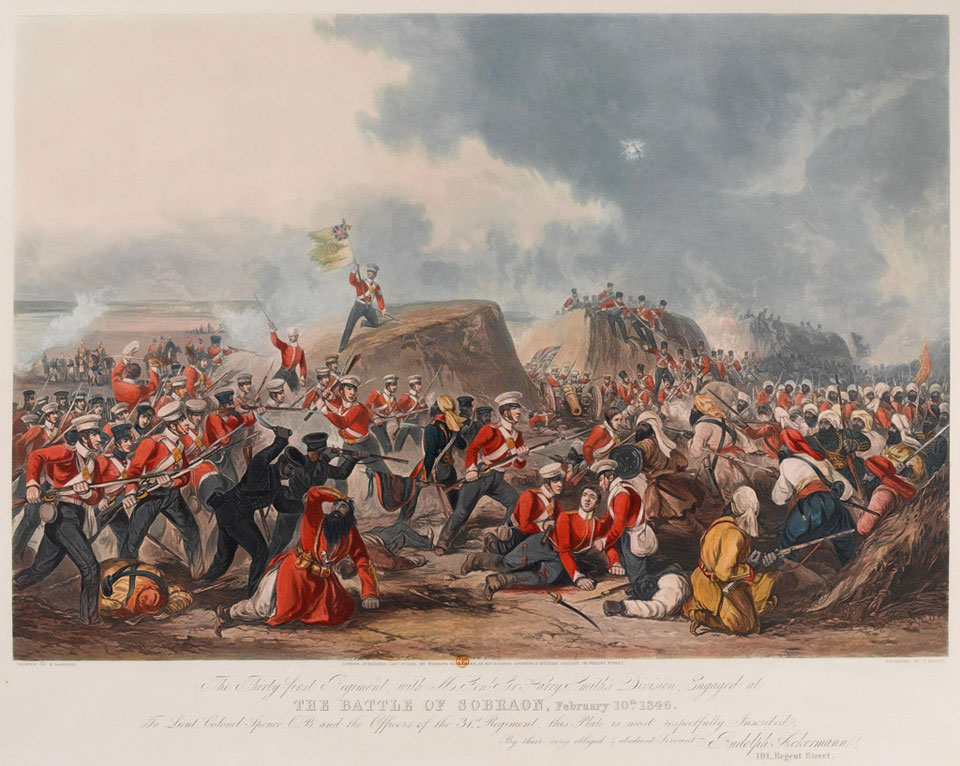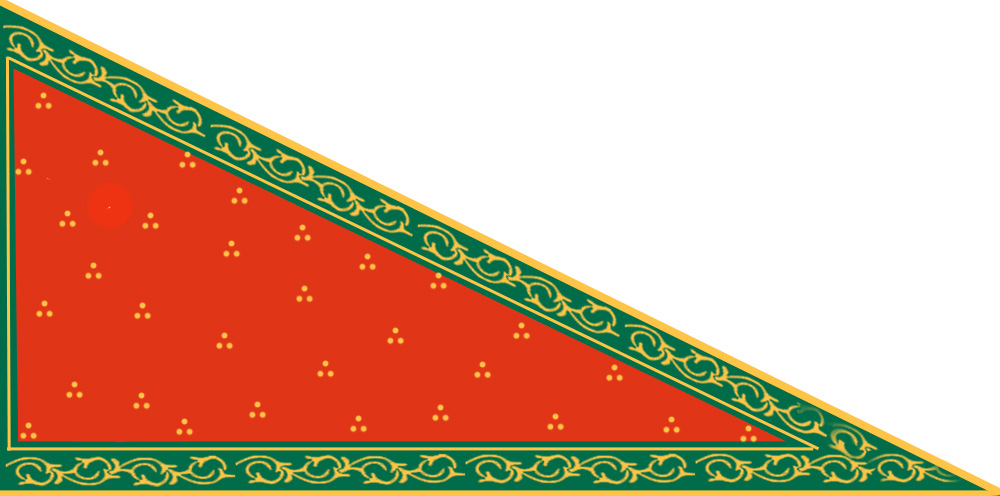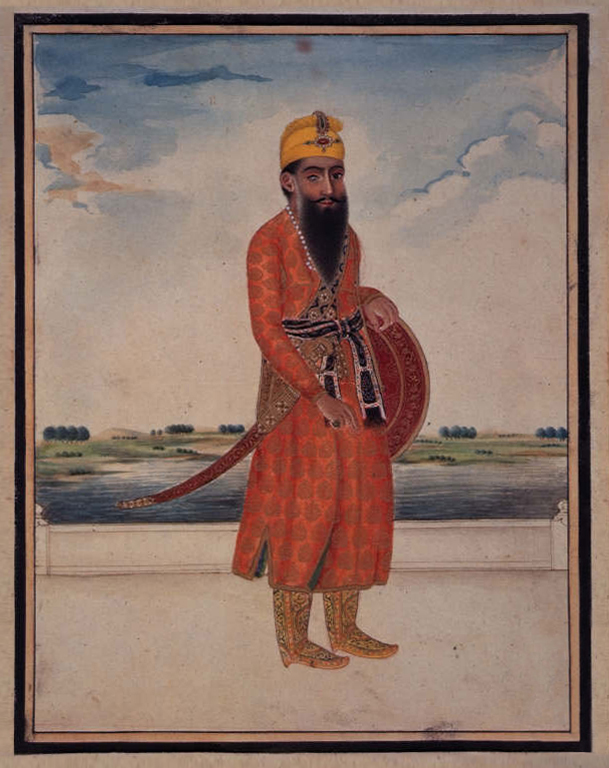|
Kampu-i-mu'alla
In 1822, after Maharaja Ranjit Singh gave employment to the European mercenaries, the Fauj-i-Ain divided unequally into the Kampu-i-mu'alla (State Troops) and the Fauj-i-Khas. Of the two, the Kampu-i-mu'alla was the larger trained division of the Sikh Khalsa Army comprising infantry, cavalry and artillery, but principally the infantry and artillery. The men enrolled in the Kampu-i-mu'alla wore uniforms and received a salary from the royal treasury. The Kampu-i-mu'alla had a mistrikhana (workshop), toshakhanna (treasury), a magazine (ammunition storage), a bazaar (shops), a daftar (record-keeping) and abkari (liquor tax) units. Background The Sukerchakia forces inherited by Ranjit Singh from his father and grandfather comprised predominantly irregular cavalry, well-suited to meet the contingencies presented in the north west frontier of the Indian subcontinent in the eighteenth century. In the early years, Ranjit Singh often led his forces. The meteoric rise of the Company impre ... [...More Info...] [...Related Items...] OR: [Wikipedia] [Google] [Baidu] |
Fauj-i-Ain
The Fauj-i-Ain (Punjabi: ਫੌਜ -ਏ-ਐਨ, Persian: فوج عین) was a branch of the Sikh Khalsa Army and was the regular army of Maharaja Ranjit Singh of Punjab. It contained infantry, cavalry and artillery units. The Fauj-i-Ain had two divisions, the Kampu-i-mu'alla (State Troops), and the Fauj-i-Khas (Special Force). Background Before the reign of Maharaja Ranjit Singh the armies in Punjab, were purely cavalry. After Ranjit Singh became the Sardar of the Sukerchakia Misl, he unified the Misls through diplomacy, strategic marital alliances and conquest. Punjab under Maharaja Ranjit Singh stretched from Kashmir to the Khyber Pass. The Afghans posed a threat to the western frontier of his kingdom, the East India Company to the eastern frontier and the Gurkhas to the northeast. In 1805, he started recruiting deserters from the East India Company as officers or soldiers and commenced training a section of his army in military drill. Trained cannoneers from Pierre Cuilli ... [...More Info...] [...Related Items...] OR: [Wikipedia] [Google] [Baidu] |
Sikh Khalsa Army
The Sikh Khalsa Army (), also known as Khalsaji or simply Sikh Army, was the military force of the Sikh Empire. With its roots in the Khalsa founded by Guru Gobind Singh, the army was later modernised on Franco-British principles by Maharaja Ranjit Singh.''The Sikh Army 1799–1849'' By Ian Heath, Michael Perry It was divided in three wings: the Fauj-i-Khas (elites), Fauj-i-Ain (regular force) and Fauj-i-Be Qawaid (irregulars). Due to the lifelong efforts of the Maharaja and his European officers, it gradually became a prominent fighting force of Asia.''History of the Punjab'' by Prof Manjeet Singh Sodhi ) Ranjit Singh changed and improved the training and organisation of his army. He reorganized responsibility and set performance standards in logistical efficiency in troop deployment, manoeuvre, and marksmanship. He reformed the staffing to emphasize steady fire over cavalry and guerrilla warfare, improved the equipment and methods of war. The military system of Ranjit Singh com ... [...More Info...] [...Related Items...] OR: [Wikipedia] [Google] [Baidu] |
Maharaja Ranjit Singh
Ranjit Singh (13 November 1780 – 27 June 1839) was the founder and first maharaja of the Sikh Empire, in the northwest Indian subcontinent, ruling from 1801 until his death in 1839. Born to Maha Singh, the leader of the Sukerchakia Misl, Sukerchakia Misl, Ranjit Singh survived smallpox in infancy but lost Monocular vision#In human species, sight in his left eye. At the age of ten years old, he fought his first battle alongside his father. After his father died around Ranjit's early teenage years, he became leader of the Misl. Ranjit was the most prominent of the Sikh leaders who opposed Zaman Shah Durrani, Zaman Shah, the ruler of Durrani Empire, during his third invasion. After Zaman Shah's retreat in 1799, he captured Lahore from the Sikh triumvirate which had been ruling it Sikh period in Lahore#Sikh triumvirate, since 1765. At the age of 21, he was formally crowned at Lahore. Before his rise, the Punjab had been fragmented into a number of warring Sikh (known as misl ... [...More Info...] [...Related Items...] OR: [Wikipedia] [Google] [Baidu] |
Fauj-i-Khas
The ''Fauj-i-Khas'' was a brigade of the Fauj-i-Ain section of the Sikh Khalsa Army of Punjab. It consisted of very experienced elites and had separate flag and emblem. It was strictly disciplined on French pattern. All the equipment and weapons were of the best type. It grew to be the best organised section of the regular army (Fauj-i-Ain) Background Before the reign of Maharaja Ranjit Singh the armies in Punjab were consisting purely of cavalry. As Ranjit Singh became the Sardar of Sukerchakia Misl he tried to unify with his conquests most of the Punjab. With clever diplomacy and many battles he gradually unified most of Punjab under him. However the Afghans, The British and the Gurkhas were still a very big threat, while his empire was still in its infancy. Therefore, in 1805, he started recruiting regular forces and employing East India Company deserters as officers or soldiers. This didn't go very well as most of these deserters were constantly in touch with the British. Th ... [...More Info...] [...Related Items...] OR: [Wikipedia] [Google] [Baidu] |
Khalsa Darbar Records
Khalsa Darbar records, also known as Lahore Darbar records, refers to the official government documents produced by the Sikh Empire's administration in India and Pakistan (which was referred to as the ''Khalsa Darbar'' or ''Lahore Darbar''). The records cover various aspects of the state, such as civil, military, and revenue administration. Dating The extant records covers the years 1811–1849 (Samvat 1868 to Chet (month), Chet 1906 Vikram Samvat, B.S.), covering a period of 38 years, though the Pakistani government claims to possess records dating earlier to 1804. Classification Much of the extant Khalsa Darbar records relate to the economic/financial management system of the Sikh Empire. The economic-related records can be divided into four categories. Some of the records relate to correspondences and treaties between the East India Company, British East India Company and the Sikh Empire. Daftar-i-Fauj The ''Daftar-i-Fauj'' records relate to the army. This category of ... [...More Info...] [...Related Items...] OR: [Wikipedia] [Google] [Baidu] |
Sikh Empire
The Sikh Empire was a regional power based in the Punjab, Punjab region of the Indian subcontinent. It existed from 1799, when Maharaja Ranjit Singh captured Lahore, to 1849, when it was defeated and conquered by the East India Company, British East India Company following the Second Anglo-Sikh War. At its peak in the mid-19th century the empire extended from Gilgit and Tibet under Qing rule, Tibet in the north to the Thar Desert, deserts of Sindh in the south and from the Khyber Pass in the west to the Sutlej in the east, and was divided into eight provinces. Religiously diverse, with an estimated population of 4.5 million in 1831 (making it the List of countries by population in 1800, 19th most populous state at the time), it was the last major region of the Indian subcontinent to be annexed by the British Raj, British Empire. In 1799, Ranjit Singh of Sukerchakia Misl captured Lahore from the Sikh triumvirate which had been ruling it Sikh period in Lahore#Sikh triumvirate ... [...More Info...] [...Related Items...] OR: [Wikipedia] [Google] [Baidu] |
Durrani Empire
The Durrani Empire, colloquially known as the Afghan Empire, or the Saddozai Kingdom, was an Afghanistan, Afghan empire founded by the Durrani tribe of Pashtuns under Ahmad Shah Durrani in 1747, which spanned parts of Central Asia, the Iranian plateau, and the Indian subcontinent. At its peak, it ruled over present-day Afghanistan, much of Pakistan, parts of northeastern and southeastern Iran, eastern Turkmenistan, and northwestern India. Next to the Ottoman Empire, the Durrani Empire is considered to be among the most significant List of Muslim states and dynasties, Islamic empires of the second half of the 18th century. Ahmad was the son of Muhammad Zaman Khan (an Afghan (ethnonym), Afghan chieftain of the Durrani, Abdali tribe) and the commander of Nader Shah, Nader Shah Afshar. Following Afshar's death in June 1747, Ahmad secured Afghanistan by taking Kandahar, Ghazni, Kabul, and Peshawar. After his accession as the nation's king, he changed his tribal name from ''Abdali'' ... [...More Info...] [...Related Items...] OR: [Wikipedia] [Google] [Baidu] |
Battle Of Nowshera
The Battle of Nowshera (; , ) was fought in Nowshera in March 1823 collectively by the Yusufzai and Khattak tribesmen, supported by the Peshawar sardars, alongside Azim Khan Barakzai, the Afghan governor of Peshawar, where they would face the Sikh armies led by Maharaja Ranjit Singh. Ganda Singh (1986) ''Maharaja Ranjit Singh: First Death Centenary Memorial''. Nirmal Publishers Azim Khan was a half-brother of Dost Mohammad Khan, the future ruler of Kabul, and later Afghanistan. The battle was a victory for the Sikhs over Azim Khan's armies, a result which allowed the Sikhs to begin their occupation of the Peshawar Valley. Joseph Greenwood (1844) ''Narrative of the late Victorious Campaigns in Afghanistan: under General Pollock; with recollections of seven years'service in India''.London:H.Colburn. Following their victory, the Sikhs destroyed the Afghan royal court and the fort of Bala Hissar, Peshawar. However, Hari Singh Nalwa, commander-in-chief of the Sikh army, soon com ... [...More Info...] [...Related Items...] OR: [Wikipedia] [Google] [Baidu] |
East India Company
The East India Company (EIC) was an English, and later British, joint-stock company that was founded in 1600 and dissolved in 1874. It was formed to Indian Ocean trade, trade in the Indian Ocean region, initially with the East Indies (South Asia and Southeast Asia), and later with East Asia. The company gained Company rule in India, control of large parts of the Indian subcontinent and British Hong Kong, Hong Kong. At its peak, the company was the largest corporation in the world by various measures and had its own armed forces in the form of the company's three presidency armies, totalling about 260,000 soldiers, twice the size of the British Army at certain times. Originally Chartered company, chartered as the "Governor and Company of Merchants of London Trading into the East-Indies," the company rose to account for half of the world's trade during the mid-1700s and early 1800s, particularly in basic commodities including cotton, silk, indigo dye, sugar, salt, spices, Potass ... [...More Info...] [...Related Items...] OR: [Wikipedia] [Google] [Baidu] |
Dewan Mokham Chand
Diwan Mokham Chand (died 16 or 29 October 1814) was one of the chief commanders of the Sikh Empire. He conquered Attock from the Durrani Afghans in 1813 and subdued the Rajputs in the Hills of Himachal and in Jammu at Jasrota, Chamba, and Basroli. He also commanded one of the early Sikh expeditions to conquer Kashmir that ended in failure due to bad weather blocking the passes to the valley. Mokham Chand was born in a Hindu Khatri family. Early life Mokham Chand was born in a Hindu Khatri family of a Kochhar background, to Vaisakhi Mal, a tradesman of the village Kunjah near Gujrat.Khushwant Singh. ''A history of the Sikhs''. Volume 1 page 217. Before taking up work under Ranjit Singh, he had worked under Dal Singh Gill of Akalgarh as a ''munshi'' (accountant) until 1804 when Dal Singh would die. After Dal Singh Gill's passing, his widow, Sehju, did not get along with Mokham Chand and therefore the latter sought employment elsewhere. His next stint was with Sahib Si ... [...More Info...] [...Related Items...] OR: [Wikipedia] [Google] [Baidu] |
Misr Diwan Chand
Misr Diwan Chand (1755 – 18 July 1825) was a notable officer and a powerful general of Maharaja Ranjit Singh's reign. From a petty clerk he rose to the position of chief of artillery and commander-in-chief of the armies that conquered Multan and Kashmir and also served as the Commander-in-Chief of the Khalsa Army from 1816 to 1825.Punjab History Conference, Thirty-ninth session, March 16–18, 2007: proceedings, Navtej Singh, Punjabi University. Dept. of Punjab Historical Studies Early life Diwan Chand was the son of a Brahmin shopkeeper of Gondlanwala village (in present-day Gujranwala, Pakistan). Military career Diwan Chand was bestowed the title of ''Zafar-Jang-Bahadur''—Brave Victor of Battles—by Ranjit Singh. Diwan Chand rose from the post of Artillery Chief to the Chief Commander of Khalsa Army in 1816. He suppressed the rebellion of Tiwana nawab of Mitha Tiwana and forced him to pay tribute. Diwan Chand captured Multan in 1818 and governor Muzzafar Khan and seve ... [...More Info...] [...Related Items...] OR: [Wikipedia] [Google] [Baidu] |
Tej Singh
Tej Singh (1799 – 4 December 1862; or Raja Teja Singh) was a Sikh commander in the Sikh Empire. He was appointed as commander-in-chief of the Sikh Khalsa Army during the First Anglo-Sikh War betraying the army he was supposed to lead. In return for his loyalty to the invader, the East India Company made Tej Singh Raja of Sialkot. It appointed him to head the Council of Regency on behalf of the minor Duleep Singh, Dalip Singh. He was one of six signatories to the 1849 Treaty of Lahore, which agreed to the surrender of the Koh-i-Noor diamond by the Maharaja of Lahore to the Queen of England. All the signatories, on behalf of the minor Dalip Singh, endorsed the treaty in return for being permitted to retain their jagirs. Biography Early life Tej Singh was born as Tej Ram in 1799 into a Gaur Brahmins, Gaur Brahmin family. His father was Misr Niddha of Meerut district, who was commander of the Sikh Khalsa Army. He was a relative of Khushal Singh Jamadar, Jamadar Khushal Si ... [...More Info...] [...Related Items...] OR: [Wikipedia] [Google] [Baidu] |







